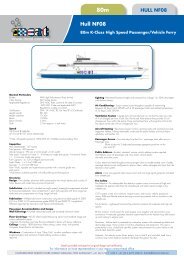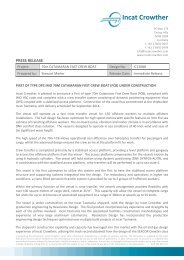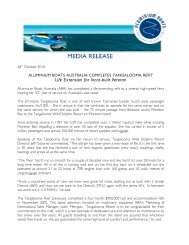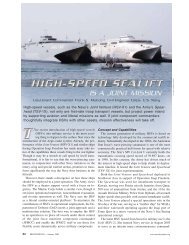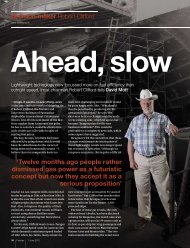US NAVY'S - Incat
US NAVY'S - Incat
US NAVY'S - Incat
You also want an ePaper? Increase the reach of your titles
YUMPU automatically turns print PDFs into web optimized ePapers that Google loves.
Improving exhaust emissions and fuel consumption<br />
involves the engine builder’s grasp of combustion<br />
and thus goes to the very heart of the matter.<br />
“Combustion is obviously the central science of<br />
combustion engines and MAN Diesel has special<br />
advantages,” he continues. “Unique among<br />
builders of medium speed engines, as well as<br />
designing, developing and producing the engine<br />
itself we have a great fund of knowledge and<br />
experience with strategic components and systems<br />
like turbochargers, fuel injection equipment,<br />
electronic hardware and engine control software.<br />
Using this expertise, we were able to reduce the<br />
specific fuel consumption of the 28/33D by some 5<br />
to 7% without affecting NOx emissions, compared<br />
with its immediate predecessor, the RK 270.”<br />
The reference to electronics is important since<br />
advanced digital engine management is the<br />
enabling technology of increasingly accurate and<br />
flexible control of parameters affecting combustion.<br />
“Fuel injection, turbocharging, valve timing and<br />
thermal engine management are the primary<br />
measures we use to enhance fuel efficiency and<br />
lower exhaust emissions ’at source’ i.e. in the<br />
combustion chamber,” Koch states. “The electronic<br />
hardware and software we use on the 28/33D<br />
will continue to give us scope for improvements.<br />
With all our in-house expertise in the key engine<br />
technologies at MAN Diesel, the software we write<br />
ourselves includes very accurate mathematical<br />
models of engine processes and thus gives very<br />
precise control.”<br />
Continuous Development<br />
The 28/33D already offers market leading values<br />
for emissions and fuel consumption, but technical<br />
milestones which will bring further improvements are<br />
pre-programmed into the MAN Diesel continuous<br />
development process. Already under preparation,<br />
and due for introduction later in 2008, for example,<br />
is the next step in electronic engine management,<br />
MAN Diesel’s advanced “SaCoSone” system. The<br />
acronym stands for “Safety and Control System”<br />
and the suffix for “on engine, since the system<br />
is very compact and mounted entirely on the<br />
structure of the 28/33D.<br />
Together with the 28/33D’s fuel injection system with<br />
solenoid valve controlled injectors, SaCoSone will allow<br />
very precise “shaping” of the rate and timing of fuel<br />
injection and hence greater control over combustion.<br />
“This technology will be an important aspect in<br />
undercutting IMO Tier 2 NOx emissions limits,” Koch<br />
states.<br />
Early Closing for Miller Light<br />
Further plans to reduce NOx emissions and fuel<br />
consumption on the 28/33D include a package of<br />
modifications to enable the so-called “Miller” process.<br />
Named after its inventor, the Miller process involves<br />
closing the inlet valve early so that air entering the<br />
cylinder expands and cools to reduce combustion<br />
temperature peaks. In fact, over 90% of NOx is formed<br />
due to temperature peaks during combustion and<br />
an elegant way to eliminate the peaks is to cool<br />
the combustion air entering the cylinders. “One well<br />
established method is the charge air cooler (a.k.a.<br />
intercooler or aftercooler), another the Miller process,”<br />
Koch observes. “On the 28/33D we achieve a “light”<br />
Miller process using a revised inlet cam profile to close<br />
the inlet valve slightly earlier. Plans call for this to be<br />
complemented by a turbocharger that delivers air<br />
to the cylinders at higher pressure. This ensures we<br />
still get the same amount of air into the cylinders in<br />
spite of shorter valve opening, to the benefit of both<br />
performance and fuel consumption.<br />
No Smoking<br />
Concluding, Koch notes that the sum of all these steps<br />
will help the 28/33D diesel engine maintain its market<br />
leading fuel consumption values and achieve emissions<br />
levels decisively below the limits of IMO Tier 2 - ahead<br />
of its implementation.<br />
Finally, he points to a very vital aspect for INCAT.<br />
“On passenger vessels it is especially important to<br />
achieve visibly clean combustion with minimal fouling.<br />
The measures we aim to introduce on the 28/33D<br />
will promote smoke-free exhaust gases under all the<br />
operating conditions the 28/33D engine will meet on<br />
an INCAT catamaran.”<br />
20 <strong>Incat</strong> THE Magazine Issue 36



